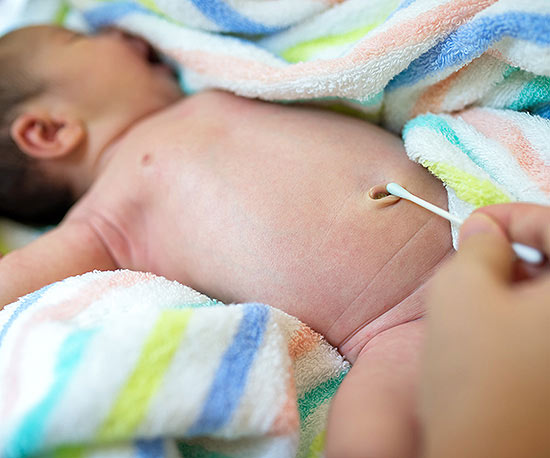
If the Umbilical Cord Is Still Intact …
Experts once advised parents to clean the cord with rubbing alcohol at every diaper change, but now the recommendation is to clean it several times a day and keep it dry.
Get Prepared
Gather all of the items you'll need before you start the cleaning process (remember, never leave your baby unattended on an elevated surface or near water). To keep the cord from getting wet, babies can have only sponge baths before the cord falls off (usually within two weeks of birth), so get a large absorbent towel to lay your baby on, a sponge or soft towels, cotton swabs, a small bowl of water, and baby soap or cleanser (if required), and keep clean clothes and a diaper nearby.
Wash Your Hands
Lather up before handling your baby's umbilical cord. "Washing your own hands prevents the chance of spreading any germs that might cause infection," says Mary Ann LoFrumento, M.D., medical director of the newborn nursery at Goryeb Children's Hospital, in Morristown, New Jersey.
Do a Quick Inspection
Look for signs of infection. "The things you want to be on the lookout for are a smelly cord, foul-smelling discharge, oozing pus from the umbilical cord, redness, tenderness or swelling of the surrounding skin, continuous bleeding, fever, lethargy, poor feeding, or irritability," says Margaret Grell, M.D., a pediatrician at Joe DiMaggio Children's Hospital in Hollywood, Florida. If you notice any of these symptoms, call your pediatrician immediately.
Wipe the Cord Down
Dip a cotton swab in warm water. Squeeze the tip to remove the excess water. Gently clean around the base of the cord and then the surrounding skin, then hold the stump with a clean absorbent cloth to dry it completely. It is important that the umbilical cord remain clean and dry until it falls off naturally. In the past, people used alcohol to clean umbilical cords in the past, but it's no longer recommended because research shows that cords fall off sooner when allowed to dry naturally. If there's urine or poop in the cord area, it's no biggie. Simply clean it with a cotton swab dipped in soapy warm water, then dry the cord completely with a clean absorbent cloth. Also cleanse the surrounding skin, says Dr. Grell.
Dry the Cord
Hold a clean, dry washcloth over the area gently or use a piece of paper to fan it dry. Don't cover the stump when you put on your baby's diaper. Fold the front of the diaper down or use one with a cutout for the umbilical cord.
Skip the Extras
Don't use any lotion, powder, or oils on or around your baby's umbilical cord. They are unnecessary and can possibly cause infection, says Dr. LoFrumento.
If the Umbilical Cord Has Fallen Off …
… you can begin to bathe your baby in a shallow baby tub of lukewarm water. Simply clean the belly button area with soap and water when you bathe your baby.
Gather Your Cleaning Materials
Your baby is probably getting real and regular baths now, so get a soft washcloth, a mild baby soap or cleanser, and a towel for drying. Fill the sink or baby tub with 2 to 3 inches of warm water.
Wash Your Hands
Even though the belly button is less likely to get infected at this point, it's still a good idea to wash your hands before and after tending to your baby's hygiene.
Wipe the Belly Area
Clean your baby's belly button after washing her face, eyes, hair, and upper body. Take the washcloth, gently wipe in and around the belly button, rinse the area, and then finish the bath, says Dr. LoFrumento.
Dry the Belly Button
Dry the belly button the same way you would dry the other parts of your baby's body. Use a clean, dry towel and gently pat it on the area, making sure you thoroughly dry the inside of the belly button if your baby has an innie.
Moisturize the Belly
It's fine to use baby lotion around the belly area after the navel heals. But apply the lotion lightly and steer clear of using any adult products that might irritate baby's sensitive skin.
Copyright © 2015 Meredith Corporation.
All content on this Web site, including medical opinion and any other health-related information, is for informational purposes only and should not be considered to be a specific diagnosis or treatment plan for any individual situation. Use of this site and the information contained herein does not create a doctor-patient relationship. Always seek the direct advice of your own doctor in connection with any questions or issues you may have regarding your own health or the health of others.


